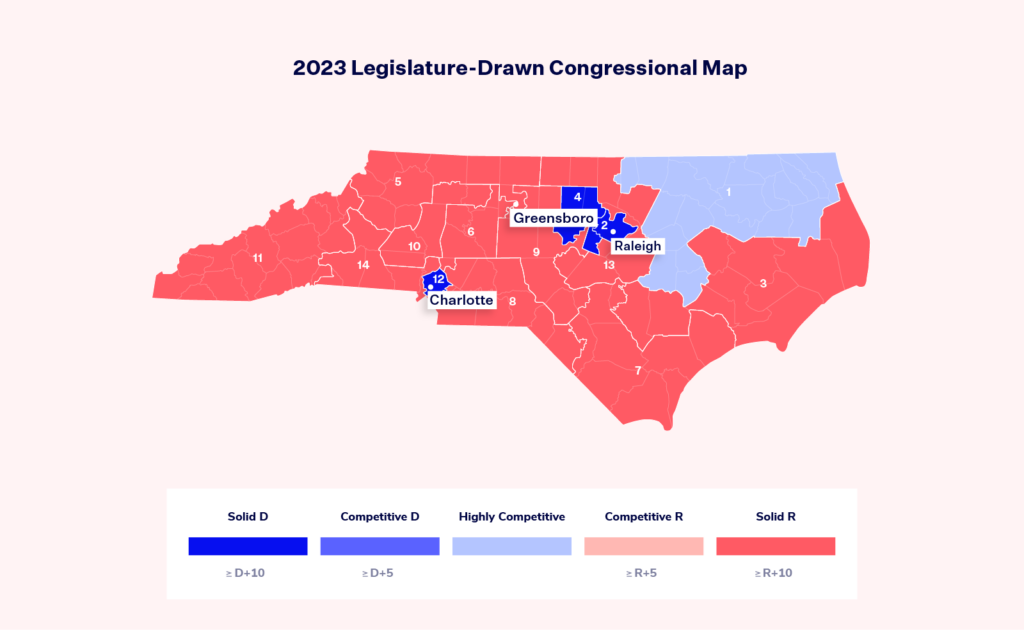North Carolina Republicans Enact Highly Gerrymandered New Maps
WASHINGTON, D.C. — On Wednesday, Oct. 25, North Carolina Republicans passed new, highly gerrymandered congressional and legislative maps as well as a county board of commissioners map. The drafts were unveiled just last week.
The new congressional map has 10 Republican districts, three Democratic districts and only one competitive district. Democratic Reps. Kathy Manning, Jeff Jackson and Wiley Nickel are all eliminated and Don Davis is drawn into a hard-to-win district with a substantially diluted Black voting population. The three remaining Democratic districts have become packed with Democratic voters.
Last year’s remedial map — which was drawn by court-appointed experts and was only in place for the 2022 midterms — had seven Republican districts, six Democratic districts and only one competitive district. It yielded a 7-7 split in congressional delegates following the 2022 election.

The new legislative maps will further entrench Republicans’ supermajorities in both chambers. The maps used last year yielded a 28-22 Republican advantage in the Senate and a 69-51 Republican advantage in the House. Data analysis from Dave’s Redistricting suggests that only three of the 120 House districts would be competitive. The state House map “significantly under-elects” Democrats and will likely maintain a Republican supermajority, regardless of turnout. Similarly, the state Senate map is also likely to preserve a Republican supermajority, even when Democrats receive more than 50% of the vote share.
State Sen. Jay Chaudhuri, a Democrat being double-bunked with another Democratic state senator, asked yesterday ahead of the Senate’s vote, “Why even hold elections, when the maps are rigged from the beginning?”
Though seemingly small in comparison to the other new maps enacted, the new Watauga County Commissioners map, which transforms the election of the commissioners from an at-large system into a single-member system, is drawn to heavily favor Republicans. The rural, western North Carolina county is home to Appalachian State University and is a reliable blue county. The five-member commission is currently split 3-2, with Democrats in the slim majority. Republican legislators have also made similar alterations in smaller jurisdictions, switching from at-large to single-member districts in the state’s most populous county, Wake, and in the cities of Winston-Salem and Gastonia.
As the poster child of gerrymandering, North Carolina has the lowest percentage of voters registered in the country. The dismal rate is a direct consequence of politicians drawing uncompetitive districts for decades. As one voter, from the gerrymandered city of Wilmington, described the effect, “People don’t feel like they’re represented, to the point where they don’t even want to vote anymore.” It’s a positive feedback loop that places the burden of breaking the cycle on the voter — whose vote has been purposefully weakened.
Analysis from Duke University found that the proposed maps are “even less responsive than the originally overturned plan from 2021 and lean more Republican than either the overturned plan drawn by the legislature in 2021.”
In Monday’s House Redistricting Committee meeting, Rep. Destin Hall (R), who chairs the committee, admitted what is abundantly and objectively clear: “Our overarching goal in the creation of this House plan was to create Republican-leaning districts where possible while… following traditional redistricting principles.” It remains to be seen if these allegedly “compliant” maps are challenged in court.
Any litigation challenging the maps enacted today will need to begin quickly as the state’s primary is March 5. As always, with new maps and districts come new candidates, but those seeking higher office will not have much time to decide if their would-be campaigns are viable. Candidate filing for 2024 begins on Dec. 4 and closes on Dec. 15.
Learn more about why the maps were redrawn here.
Read more about North Carolina’s redistricting journey here.